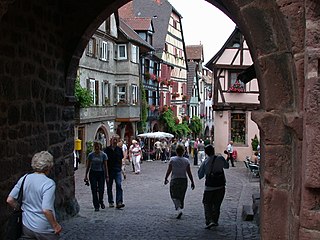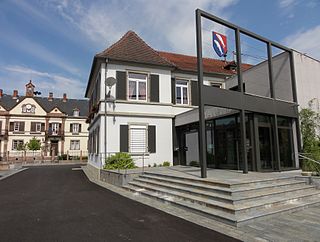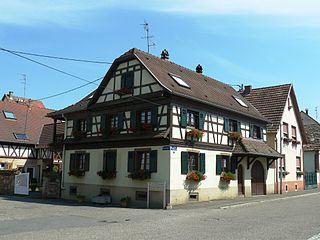
Bas-Rhin is a department in Alsace which is a part of the Grand Est super-region of France. The name means 'Lower Rhine', referring to its lower altitude among the two French Rhine departments: it is downstream of the Haut-Rhin department. Note that both belong to the European Upper Rhine region. It is, with the Haut-Rhin, one of the two departments of the traditional Alsace region which until 1871, also included the area now known as the Territoire de Belfort. The more populous and densely populated of the pair, it had 1,148,073 inhabitants in 2020. The prefecture is based in Strasbourg. The INSEE and Post Code is 67.

Sélestat is a commune in the Grand Est region of France. An administrative division (sous-préfecture) of the Bas-Rhin department, the town lies on the Ill river, 17 kilometres (11 mi) from the Rhine and the German border. Sélestat is located between the largest communes of Alsace, Strasbourg and Mulhouse.

Riquewihr is a commune in the Haut-Rhin department in Grand Est in north-eastern France.

Rosheim is a commune in the Bas-Rhin department in Grand Est in north-eastern France.

Erstein is a commune in the Bas-Rhin department, in the region of Grand Est, France.

Huttenheim is a commune in the Bas-Rhin department in Grand Est in north-eastern France.

Dambach-la-Ville is a commune in the Bas-Rhin department in Alsace in north-eastern France.

Scherwiller is a commune in the Bas-Rhin department in Alsace in northeastern France. Residents are referred to as Scherwillerois in French.

Barr is a commune in the Bas-Rhin department in the Alsace region of north-eastern France.

Gertwiller is a commune in the Bas-Rhin department in Alsace in north-eastern France.

Krautergersheim is a commune in the Bas-Rhin department in Alsace in north-eastern France. It lies between Strasbourg and Obernai.

Innenheim is a commune in the Bas-Rhin department in Alsace in north-eastern France.

Fort-Louis is a commune in the Bas-Rhin department in Grand Est in north-eastern France.

Gerstheim is a commune in the Bas-Rhin department in Alsace in north-eastern France.

Herrlisheim is a commune in the Bas-Rhin department in Grand Est in north-eastern France. The town dates from the 8th century. Herrlisheim was the scene of very heavy fighting during Operation Nordwind, an offensive launched by the German Army during World War II that inflicted considerable damage to the town.

Hilsenheim is a commune in the Bas-Rhin department in Alsace in north-eastern France.

Limersheim is a commune in the Bas-Rhin department in Alsace in north-eastern France. It is a rural tourist destination, boasting several half-timbered houses.

Ottrott is a commune in the Bas-Rhin department in Grand Est in north-eastern France. It lies southwest of Strasbourg. The vineyards in and around Ottrott produce the red Rouge d'Ottrott, a geographical denomination within the registered designation of origin Alsace AOC.

Rhinau is a commune in the Bas-Rhin department of Grand Est in north-eastern France.

Wasselonne is a commune based in the Bas-Rhin department in north-eastern France, more precisely, in the Grand Est region. The oldest firm of unleavened bread in France: Etablissements René Neymann, is located in this town.



























